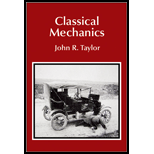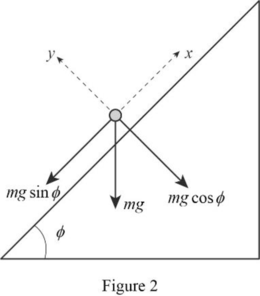
The position of the ball as a function of time and to show that the range of the ball is
Answer to Problem 1.39P
The position of the ball as a function of time is
Explanation of Solution
Assume positive x-axis to be pointing up along the inclined plane and the positive y-axis to be pointing normal to the inclined plane.
The velocity components of the ball are shown in figure 1.

Write the equation for the component of initial velocity of the ball in x-direction.
Here,
Write the equation for the component of initial velocity of the ball in y-direction.
Here,
The weight components of the ball are shown in figure 2.

From the diagram, it is clear that the only force acting on the ball in x-direction is sine component of the weight of the ball.
Write the equation for the net force on the ball in x-direction.
Here,
Write the equation for net force in x-direction.
Here,
Compare the above two equations and write the equation for the acceleration of the ball in x-direction.
Write the equation for the displacement of the ball along x-axis during time
Here,
Put equations (I) and (III) in equation (II).
From the diagram, it is clear that the only force acting on the ball in y-direction is cosine component of the weight of the ball.
Write the equation for the net force on the ball in y-direction.
Here,
Write the equation for net force in y-direction.
Here,
Compare the above two equations and write the equation for the acceleration of the ball in y-direction.
Write the equation for the displacement of the ball along y-axis during time
Here,
Put equations (II) and (VI) in equation (VII).
Write the expression for the displacement of the ball along the
Here,
Write the equation for the position of the ball after time
Here,
Put equations (V), (VIII) and (IX) in the above equation.
When the ball lands on the inclined plane, its total displacement in y-direction will be zero.
Substitute
Here,
The horizontal displacement of the ball during the time of flight is its range.
Put the above equation in equation (V) to find the expression for the range.
Here,
The range will be maximum when the first derivative of the range with respect to the angle of projection is zero.
Write the condition for maximum range.
Take the derivative of equation (X) with respect to
Put the above equation in equation (XI).
The value of
Equate
Substitute the above determined value of
Here,
Use the trigonometric identity
Conclusion:
Therefore, the position of the ball as a function of time is
Want to see more full solutions like this?
Chapter 1 Solutions
Classical Mechanics
 College PhysicsPhysicsISBN:9781305952300Author:Raymond A. Serway, Chris VuillePublisher:Cengage Learning
College PhysicsPhysicsISBN:9781305952300Author:Raymond A. Serway, Chris VuillePublisher:Cengage Learning University Physics (14th Edition)PhysicsISBN:9780133969290Author:Hugh D. Young, Roger A. FreedmanPublisher:PEARSON
University Physics (14th Edition)PhysicsISBN:9780133969290Author:Hugh D. Young, Roger A. FreedmanPublisher:PEARSON Introduction To Quantum MechanicsPhysicsISBN:9781107189638Author:Griffiths, David J., Schroeter, Darrell F.Publisher:Cambridge University Press
Introduction To Quantum MechanicsPhysicsISBN:9781107189638Author:Griffiths, David J., Schroeter, Darrell F.Publisher:Cambridge University Press Physics for Scientists and EngineersPhysicsISBN:9781337553278Author:Raymond A. Serway, John W. JewettPublisher:Cengage Learning
Physics for Scientists and EngineersPhysicsISBN:9781337553278Author:Raymond A. Serway, John W. JewettPublisher:Cengage Learning Lecture- Tutorials for Introductory AstronomyPhysicsISBN:9780321820464Author:Edward E. Prather, Tim P. Slater, Jeff P. Adams, Gina BrissendenPublisher:Addison-Wesley
Lecture- Tutorials for Introductory AstronomyPhysicsISBN:9780321820464Author:Edward E. Prather, Tim P. Slater, Jeff P. Adams, Gina BrissendenPublisher:Addison-Wesley College Physics: A Strategic Approach (4th Editio...PhysicsISBN:9780134609034Author:Randall D. Knight (Professor Emeritus), Brian Jones, Stuart FieldPublisher:PEARSON
College Physics: A Strategic Approach (4th Editio...PhysicsISBN:9780134609034Author:Randall D. Knight (Professor Emeritus), Brian Jones, Stuart FieldPublisher:PEARSON





